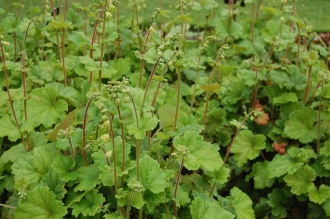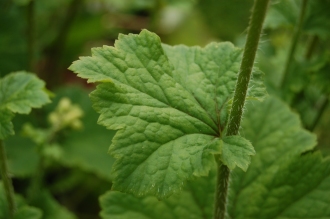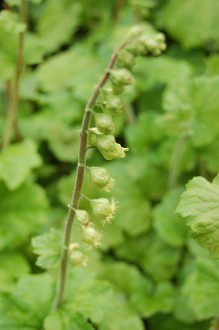Position: Partial to full shade
Flowering period: Spring
Soil: Moist, well drained
Eventual Height: 30cm (flowering 80cm)
Eventual Spread: 30cm
Hardiness: 4a, 4b, 5a, 5b, 6a, 6b, 7a, 7b, 8a, 8b, 9a
Family: Saxifragaceae
Tellima grandiflora is a low growing evergreen/ semi-evergreen, spreading, herbaceous perennial. Its mid green leaves are scalloped and rounded, hairy and they are up to 10cm long with 5 to 7 lobes. Its green flowers are deeply fringed, borne in terminal racemes that are up to 12cm long, on flower spikes that are up to 60cm long. Its fruit of the plant are capsules, about 4mm long, with brown seeds that are wrinkled and warty in appearance. This plant spreads by its spreading rhizome root system.
Tellima grandiflora, commonly known as Fringecups or Bigflower Tellima, is native west North America. In its natural habitat it grows moist forests. It is the only species in the genus Tellima. It has become naturalized in some parts of the UK.
The etymological root of the binomial name Tellima is said to be an anagram of Mitella, from which the genus was separated. Mitella is from the Greek diminutive mitre, ‘little-mitre’, referring to the seed pod shape. Grandiflora is derived from the Latin grandis ‘large’ and flora ‘flower’.
The landscape architect may find Tellima grandiflora useful as an effective evergreen herbaceous ground-cover plant, being particularly useful in shady locations. Once established this plant is drought tolerant.
Ecologically, Tellima grandiflora is of little value to UK wildlife.
Tellima grandiflora prefers moist, fertile, well-drained soils. It tolerates most pH of soil.
Tellima grandiflora requires little maintenance. Large clumps may be divided in autumn or spring.










